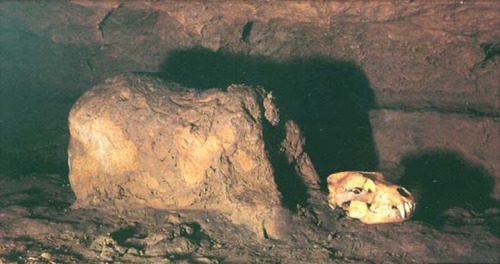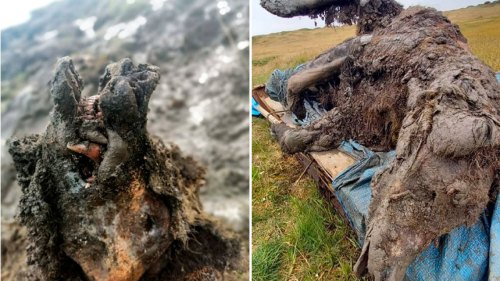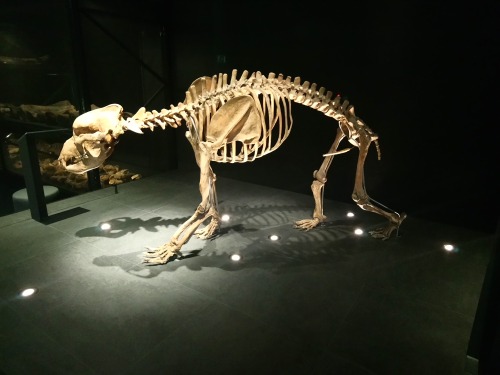Cave bearThe cave bear lived in Europe and Asia and evolved from the Ursus Deningeri (Deninger&r
Cave bearThe cave bear lived in Europe and Asia and evolved from the Ursus Deningeri (Deninger’s bear) 1,8 million to 100,000 years ago into the cave bear (Ursus spelaeus). This bear was named the cave bear because most of the fossils have been found inside caves. Whether this bear spent more time inside caves than bear species still alive until this day is not fully clear. Fossils in caves have a much better chance to be preserved. Just like the woolly mammoth, the first fossils of the cave bear were confused with other species. The fossils were first described in a book ‘newly discovered zoolites of unknown four footed animals’ by Johann Friedrich Esper back in 1774. The bones clearly confused scientists of the 18th century who thought it might belong to a species of canids, felids, apes or even a mythological creature such as a dragon. The writer of the book, Friedrich Esper, believed the fossils belonged to polar bears. It wasn’t until 20 years after the publication of the book that an anatomist, Johann Christian Rosenmüller, finally gave the species its name. Most of the cave bear fossils have been found in Austria and unfortunately during ww1, the Austrians started using earth from caves in order to win phosphate. This process destroyed a lot of the original prehistoric cave environments so that only the cave bear bones remained. The cave bear itself was absolutely massive. The shoulder height of a cave bear could reach an average of 1,31 meters and when it stood on two legs, it could reach a height of 3,5 meters. It’s the largest of all the bear species, slightly larger than the polar bear which is nowadays the largest bear species. A male cave bear could weigh about 600kg to even 1000kg while females are a lot smaller, only about 250kg. Also the teeth of the cave bear were much larger than those of modern day bear species. This means they probably didn’t have a full meat diet as you would expect from a predator of this size. The big molars of the cave bear were used to process a more plant-like diet such as tubers. Some scientists even go as far as saying that the cave bear was a solely herbivory animal. There is some evidence to back this theory up since the isotopes of cave bear bones show low levels of nitrogen-15 which is the usual case in herbivores, the levels of nitrogen inside cave bear remains are about the same as those of the woolly mammoth who also was a herbivory animal. It is however also possible that perhaps the main diet might have been vegetarian but that they did scavenge cadavers for some meat. Some scientists suggest that the cave bears ate their own kind, the ones that died during hibernation. Judging by bear behaviour in modern times, it is very well possible that the cave bear was mostly vegetarian with occasionally some meat in its diet. Early humans and cave bears had an interesting relationship with each other that is still not fully understood. An interesting example of this is the discovery inside the Drachenloch cave in Switzerland. Inside this cave, a low wall was found covered with several cave bear skulls. The positioning of the remains suggest a human touch which leads to a theory that early humans such as the Neanderthals worshiped the cave bear in a form of primitive religion. It is however impossible to proof this theory. The Drachenloch cave isn’t the only cave with such a discovery. The famous Chauvet cave has a skull chamber in which a cave bear skull has been placed on top of a rock resembling an altar. This skull has been placed there around 30,000 years ago so it might have been part of a religious ritual of our own species, homo sapiens. Another strange discovery was made in Regourdou, France. A rectangular pit was found which contained the remains of 20 bears covered by a slap. The pit was located next to another pit which contained the body of a Neanderthal buried there with objects such as a cave bear bone, scrapers and flakes, these are Neanderthal grave offerings and their burial rites might have included the worship of the cave bear. The Basura cave in Italy has a stalagmite inside that vaguely resembles a cave bear in appearance. This stalagmite is surrounded by cave bear bones which seems to have been dropped here on purpose by Neanderthals for a ritualistic purpose. Yet again we can not be fully certain about this but the fact that several caves have been found with purposefully placed cave bear bones, does suggest that both Neanderthals and us held the cave bear in high esteem. Unfortunately the cave bear went extinct somewhere around 20,000-12,000 years ago. This is slightly earlier than the extinction of most of the other megafauna such as the woolly mammoth. Scientists believed that the cave bear went extinct because of its diet. Due to climate change, the plants eaten by the cave bears slowly disappeared which meant that the bears themselves also disappeared. It would explain why the cave bear disappeared before the woolly mammoth. Another theory suggests that overhunting by humans might have been the cause but this seems unlikely. Cave bears were most likely avoided by early hunters, they were simply too dangerous to hunt thanks to their massive size.An interesting fact to notice is that the species declined rapidly around 40,000 years ago. This is around the same time when modern humans appeared in Europe and Asia. Maybe humans and cave bears were competing with each other on habitats, the caves or it was a combination of both climate change and the arrival of modern humans. Even though the species has sadly disappeared, a completely preserved cave bear cub was discovered last year in Siberia. Maybe some day in the future we can bring the species back, a cave bear would surely be magnificent to behold. Here are images of: Depiction of a cave bear from the game Far Cry Primal,Skeleton of a cave bear photographed by myself in the Naturalis, Leiden, the Netherlands,Cave bear skull in the Chauvet cave,Cave bear cub found in Siberia in 2020,A cave bear altar? found in Montespan cave, -- source link
Tumblr Blog : prehistoriceurope.tumblr.com
#history#prehistory#megafauna#europe#cave bear




